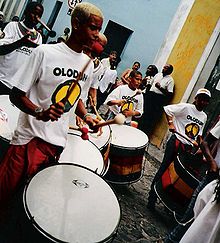| Revision as of 16:46, 16 December 2016 editLayla, the remover (talk | contribs)Extended confirmed users, Rollbackers807 edits →External links: Removing stubs, really not one← Previous edit | Revision as of 08:54, 29 December 2016 edit undoBG19bot (talk | contribs)1,005,055 editsm Remove blank line(s) between list items per WP:LISTGAP to fix an accessibility issue for users of screen readers. Do WP:GENFIXES and cleanup if needed. Discuss this at Misplaced Pages talk:WikiProject Accessibility/LISTGAPNext edit → | ||
| Line 1: | Line 1: | ||
| {{refimprove|date=October 2016}} | {{refimprove|date=October 2016}} | ||
| ]. |272x272px]]'''Axé''' ({{IPA-pt|a'ʃɛ}}) is a ] ] originated in ], ], ] in the 1980s, fusing different Afro-Caribbean ], such as marcha, ], and ]. It also includes influences of Brazilian music such as ], ] and carixada. |
]. |272x272px]]'''Axé''' ({{IPA-pt|a'ʃɛ}}) is a ] ] originated in ], ], ] in the 1980s, fusing different Afro-Caribbean ], such as marcha, ], and ]. It also includes influences of Brazilian music such as ], ] and carixada. | ||
| ⚫ | The word Axé comes from the ] culture and language, meaning “soul, light, spirit or good vibrations”.<ref name=":3">{{Cite book|url=http://site.ebrary.com/lib/northeastern/reader.action?docID=10282573&ppg=6|title=Let's Make Some Noise : Axé and the African Roots of Brazilian Popular Music|last=Henry|first=Clarence Bernard|date=August 2008|publisher=University Press of Mississippi|access-date=10 October 2016}}</ref> Axé is also present in the ] religion, as “the imagined spiritual power and energy bestowed upon practitioners by the pantheon of orixás”.<ref name=":3" /> | ||
| ⚫ | The word Axé comes from the ] culture and language, meaning “soul, light, spirit or good vibrations”. |
||
| ==Roots and History of Axé== | ==Roots and History of Axé== | ||
| Numerous different African cultures were brought to Brazil due to slavery, which lead to the creation of the vibrancy and complexity of Brazil and its culture. Therefore, several of Brazil’s popular music styles have derived from African cultures and African diasporic influences, including samba, lambada, funk and axé. There is a tendency by Brazilian musicians to draw inspiration and utilize themes, imagery and symbolic symbols from the Candomblé religion and its African roots.<ref name=":3" /> Artists such as Gilberto Gil, Vinicius de Moraes, Caetano Veloso, Sergio Mendes, Daniela Mercury, Carlinhos Brown, among others, have all used African culture, religion and symbols as inspirations and lyrics of their songs.<ref name=":3" /> | Numerous different African cultures were brought to Brazil due to slavery, which lead to the creation of the vibrancy and complexity of Brazil and its culture. Therefore, several of Brazil’s popular music styles have derived from African cultures and African diasporic influences, including samba, lambada, funk and axé. There is a tendency by Brazilian musicians to draw inspiration and utilize themes, imagery and symbolic symbols from the Candomblé religion and its African roots.<ref name=":3" /> Artists such as Gilberto Gil, Vinicius de Moraes, Caetano Veloso, Sergio Mendes, Daniela Mercury, Carlinhos Brown, among others, have all used African culture, religion and symbols as inspirations and lyrics of their songs.<ref name=":3" /> | ||
| Line 45: | Line 46: | ||
| ==External links== | ==External links== | ||
| * | * | ||
| * | * | ||
| * | * | ||
Revision as of 08:54, 29 December 2016
| This article needs additional citations for verification. Please help improve this article by adding citations to reliable sources. Unsourced material may be challenged and removed. Find sources: "Axé" – news · newspapers · books · scholar · JSTOR (October 2016) (Learn how and when to remove this message) |

Axé (Template:IPA-pt) is a popular music genre originated in Salvador, Bahia, Brazil in the 1980s, fusing different Afro-Caribbean genres, such as marcha, reggae, and calypso. It also includes influences of Brazilian music such as frevo, forró and carixada.
The word Axé comes from the Yoruba culture and language, meaning “soul, light, spirit or good vibrations”. Axé is also present in the Candomblé religion, as “the imagined spiritual power and energy bestowed upon practitioners by the pantheon of orixás”.
Roots and History of Axé
Numerous different African cultures were brought to Brazil due to slavery, which lead to the creation of the vibrancy and complexity of Brazil and its culture. Therefore, several of Brazil’s popular music styles have derived from African cultures and African diasporic influences, including samba, lambada, funk and axé. There is a tendency by Brazilian musicians to draw inspiration and utilize themes, imagery and symbolic symbols from the Candomblé religion and its African roots. Artists such as Gilberto Gil, Vinicius de Moraes, Caetano Veloso, Sergio Mendes, Daniela Mercury, Carlinhos Brown, among others, have all used African culture, religion and symbols as inspirations and lyrics of their songs.
Axé was a fusion of African and Caribbean styles such as merengue, salsa and reggae, as well as being influenced by other Afro-Brazilian musical styles such as frevo and forró. Axé music was labeled in 1980s, but it was already noticeable in the 50s with the incorporation of the “guitarra baiana” (guitar from Bahia). This genre was purely instrumental, and remained so until the 1970s, when Moraes Moreira (of the band Novos Baianos) went solo.

In 1974, carnival in Salvador, Bahia began taking shape. A group of Afro-Brazilians civil rights activists formed Ilê Aiyê, a music ensemble that derived their heavy rhythm from Candomblé’s religious ceremonies. Quickly, Ilê Aiyê gained a huge following, allowing them to influence other artists to incorporate the samba-reggae style and the heavy beats to their music. Groups such as Timbalada, Olodum and Filhos de Gandhi also shared the heavy beats and rhythms with Ilê Aiyê, as well as utilizing African symbols such as typical outfits and instruments that all these bands use to perform. Olodum's rehearsals soon became a starting point for up and coming artists, composers, and music. In these rehearsals, artists presented and experimented with their music, in search for legitimacy from the population.
In 1985 Luiz Caldas released his LP record called Magia, which included the track Fricote. Although the lyrics were not complex, the rhythm was perfect for the climate in Bahia. The song became the representation of the entertainment of Bahia's musicality.
Popularity
When Daniela Mercury released O Canto da Cidade in 1992, axé entered the mainstream pop music scene and became one of the most popular genres in Brazil. The song remained in the first position in the charts for months and ended up becoming an anthem for the people in Brazil. O Canto da Cidade opened doors for artists and bands such as Cheiro de Amor, Asa de Águia, Chiclete com Banana and Banda Eva, who launched Ivete Sangalo and lead her to embark in her solo career. These bands are still relevant in Brazilian music scene, and still spreads the axé genre across the country and throughout the world.
Two years prior to Daniela Mercury's success, the American and European released Margareth Menezes' Elegibô, which took the style to international audiences.
Notable Artists

- Ivete Sangalo
- Claudia Leitte
- Carlinhos Brown
- Chiclete com Banana
- Margaret Menezes
- Daniela Mercury
- Dodô e Osmar
- Ilê Aiyê
- Olodum
- Timbalada
- Banda Eva
Axé Today
Currently, the biggest axé music stars are Ivete Sangalo and Cláudia Leitte.
Axé Bahia is a six-member eurodance/axé music group from Brazil. They achieved fame in South America with their single "Beijo na Boca", and was also extremely popular in the Spanish-language version, "Beso en la Boca".
International Exposure of Axé

A notable moment in axé's history was Ivete Sangalo's success in the United States. After selling out 70,000 capacity soccer stadiums in Brazil, Ivete Sangalo sold out Madison Square Garden in 2010. In an interview before her MSG concert, she affirmed that, "When I started in Brazil, I was also unknown, and Brazil is a gigantic place with lots of talent. I haven't come here with the pretension of being well known, but what I've come do to here, I've come to do right". In this concert, she was able to bring to the United States a "mini-version of Carnaval". Ivete Sangalo is the only artist to have participated in all editions of the concert Rock in Rio Lisbon, as well as participating in Rock in Rio Brazil, Spain and United States.
Another remarkable instance for axé music was when Michael Jackson recorded his 1996 hit They Don't Really Care About Us in Bahia. Spike Lee directed the video clip for this song, and the video clip was filmed in the historical neighborhood of Pelourinho in Salvador, Bahia, and in a favela in Rio de Janeiro. Michael Jackson collaborated with Olodum in this video, which featured 200 members of the band playing their different kinds of drums to Salvador's samba-reggae music. Due to this video, Olodum was exposed to 140 countries, increasing the outreach of the Afro-Brazilian samba-reggae music.
References
- ^ Henry, Clarence Bernard (August 2008). Let's Make Some Noise : Axé and the African Roots of Brazilian Popular Music. University Press of Mississippi. Retrieved 10 October 2016.
- ^ Hurrell, Fiona (6 March 2012). "The Story of Axé Music in Brazil". The Rio Times. The Rio Times. Retrieved 10 October 2016.
- ^ Amado, Armando Alexandre (20 March 2010). "Axé music: mitos, verdades e world music" (PDF). Universidade Federal da Bahia. Retrieved 10 October 2016.
- Astor, Michael (5 September 2010). "Brazilian superstar Ivete Sangalo plays NY arena". The Washington Times. The Washington Times. Retrieved 10 October 2016.